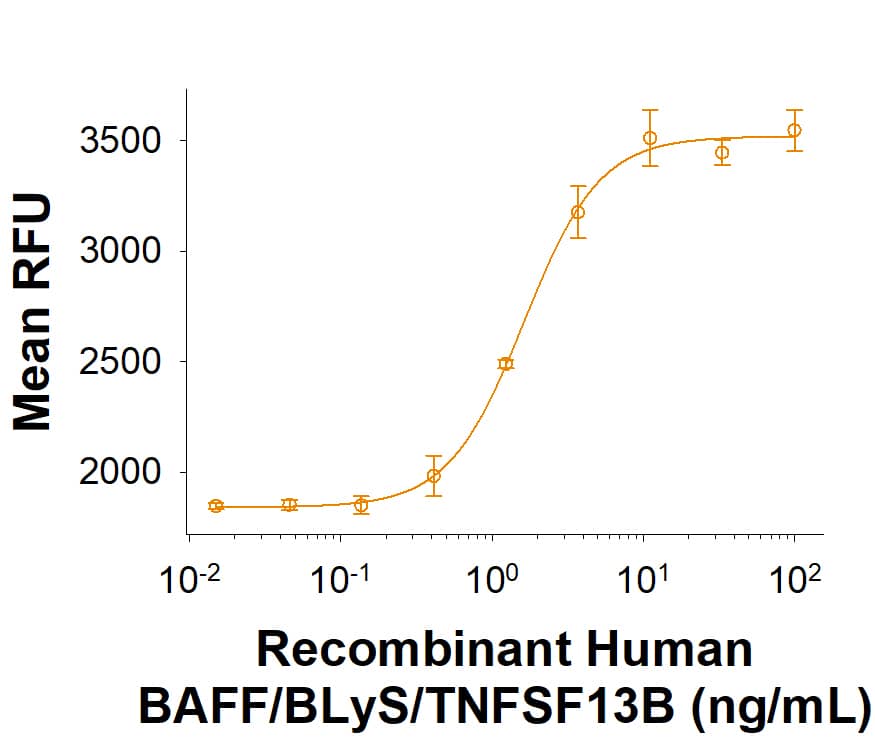Recombinant Human BAFF/BLyS/TNFSF13B His-tag Protein, CF
Recombinant Human BAFF/BLyS/TNFSF13B His-tag Protein, CF Summary
Product Specifications
The ED50 for this effect is 0.300-3.60 ng/mL.
Analysis
Product Datasheets
Carrier Free
CF stands for Carrier Free (CF). We typically add Bovine Serum Albumin (BSA) as a carrier protein to our recombinant proteins. Adding a carrier protein enhances protein stability, increases shelf-life, and allows the recombinant protein to be stored at a more dilute concentration. The carrier free version does not contain BSA.
In general, we advise purchasing the recombinant protein with BSA for use in cell or tissue culture, or as an ELISA standard. In contrast, the carrier free protein is recommended for applications, in which the presence of BSA could interfere.
11403-BF
| Formulation | Lyophilized from a 0.2 μm filtered solution in PBS with Trehalose. |
| Reconstitution | Reconstitute at 500 μg/mL in PBS. |
| Shipping | The product is shipped at ambient temperature. Upon receipt, store it immediately at the temperature recommended below. |
| Stability & Storage: | Store the unopened product at -20 to -70 °C. Use a manual defrost freezer and avoid repeated freeze-thaw cycles. Do not use past expiration date. |
Scientific Data
 View Larger
View Larger
Recombinant Human BAFF/BLyS/TNFSF13B His-tag (Catalog # 11403-BF) induces proliferation of anti-IgM stimulated mouse B cells. The ED50 for this effect is 0.300-3.60 ng/mL.
Reconstitution Calculator
Background: BAFF/BLyS/TNFSF13B
B-cell activating factor (BAFF), also known as BLyS, TALL-1, THANK, and TNFSF13B, is a 32 kDa transmembrane glycoprotein in the TNF ligand superfamily. It is involved in multiple aspects of immune system regulation, particularly towards B cells (1, 2). Mature human BAFF consists of a 46 amino acid (aa) cytoplasmic domain, a 21 aa transmembrane segment, and a 218 aa extracellular domain (ECD) with a stalk region and one TNF-like domain (3, 4). Within aa 134-285 of the ECD, human BAFF shares 72% aa sequence identity with mouse BAFF. It can be expressed as a homo-oligomer or as a heteromer in association with the related TNFSF member APRIL (4, 5). A 18 kDa fragment containing the TNF-like domain can be released by proteolysis between Arg133 and Ala134 (4). Soluble BAFF is stored intracellularly in neutrophils and released upon inflammatory stimulation (6). Alternative splicing generates an isoform termed deltaBAFF that lacks 19 aa between the proteolytic cleavage site and the TNF-like domain. deltaBAFF can form heteromers with BAFF and negatively regulates BAFF function (7). BAFF is produced by many hematopoietic cell types including monocytes, macrophages, neutrophils, dendritic cells, and T cells and also by adipocytes (1, 2, 8). Both BAFF and APRIL are functional ligands for the TNF receptor superfamily members BCMA and TACI, and BAFF additionally binds and signals through BAFF R (9, 10). All three receptors are primarily expressed by B cells (10). BAFF plays a critical role in the development and survival of B lineage cells (2, 11, 12). Mice that overexpress BAFF exhibit elevated B cell numbers, increased formation and size of germinal centers, and symptoms of autoimmunity (13). Soluble BAFF is elevated in B cell malignancies, autoimmunity, and other immune disorders (1). In addition, BAFF co‑stimulates T cell activation, promotes a Th1 biased immune response, and promotes the expansion of Treg cells (14‑16). BAFF also promotes monocyte survival, proinflammatory cytokine secretion, and differentiation to macrophages (17).
- Lied, G.A. and A. Berstad (2011) Scand. J. Immunol. 73:1.
- Mackay, F. et al. (2010) Immunol. Rev. 237:205.
- Moore, P.A. et al. (1999) Science 285:260.
- Schneider, P. et al. (1999) J. Exp. Med. 189:1747.
- Roschke, V. et al. (2002) J. Immunol. 169:4314.
- Scapini, P. et al. (2003) J. Exp. Med. 197:297.
- Gavin, A.L. et al. (2003) J. Biol. Chem. 278:38220.
- Alexaki, V.-I. et al. (2009) J. Immunol. 183:5948.
- Yu, G. et al. (2000) Nat. Immunol. 1:252.
- Thompson, J.S. et al. (2001) Science 293:2108.
- Schiemann, B. et al. (2001) Science 293:2111.
- Litinskiy, M.B. et al. (2002) Nat. Immunol. 3:822.
- Batten, M. et al. (2000) J. Exp. Med. 192:1453.
- Huard, B. et al. (2001) J. Immunol. 167:6225.
- Sutherland, A.P.R. et al. (2005) J. Immunol. 174:5537.
- Walters, S. et al. (2009) J. Immunol. 182:793.
- Chang, S.K. et al. (2006) Blood 108:2687.
FAQs
No product specific FAQs exist for this product, however you may
View all Proteins and Enzyme FAQsReviews for Recombinant Human BAFF/BLyS/TNFSF13B His-tag Protein, CF
There are currently no reviews for this product. Be the first to review Recombinant Human BAFF/BLyS/TNFSF13B His-tag Protein, CF and earn rewards!
Have you used Recombinant Human BAFF/BLyS/TNFSF13B His-tag Protein, CF?
Submit a review and receive an Amazon gift card.
$25/€18/£15/$25CAN/¥75 Yuan/¥1250 Yen for a review with an image
$10/€7/£6/$10 CAD/¥70 Yuan/¥1110 Yen for a review without an image

